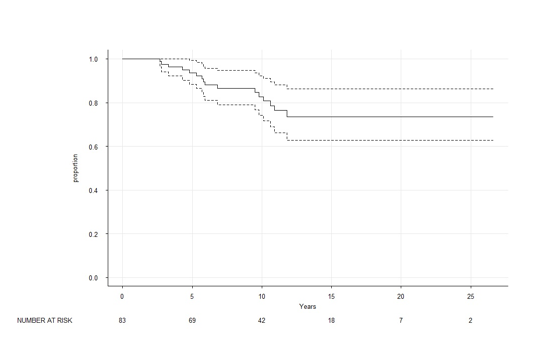Session Information
Date: Sunday, November 8, 2015
Session Type: ACR Poster Session A
Session Time: 9:00AM-11:00AM
Background/Purpose: The long-term outcome of patients with non-radiographic
axial spondyloarthritis (nr-axSpA) is unclear, particularly whether few or most
progress to ankylosing spondylitis (AS).
Our objective was to examine the progression to AS in a population-based
inception cohort of patients with nr-axSpA.
Methods: The Rochester Epidemiology Project (REP) is a
longstanding population-based study of health in residents of Olmsted County,
Minnesota. Using a combination of diagnostic and procedural codes for back
pain, HLA-B27 and pelvis MRI, we searched the REP from 1985 to 2010 for
subjects who potentially fulfilled ASAS criteria for nr-axSpA. We performed
detailed review of medical records to identify subjects who satisfied either
the ASAS clinical arm or imaging arm criteria, and followed them until March
15th, 2015. We collected
demographic, clinical, laboratory and radiology information. We used survival analysis to measure
time to progression to AS.
Results: After screening 2151 potential candidates, we
identified 83 subjects who met ASAS criteria for nr-axSpA (18 in the imaging
arm and 65 in the clinical arm). Fifty-three
percent of the subjects were men.
The average age at inclusion was 33.3 ±
8.3 years. The age of back
pain onset was 30.3 ± 7.9 years. The mean follow up was
10.6 ± 5.6 years.
Sixteen (19%) subjects developed radiographic sacroiliitis
that met modified New York criteria for AS. The probabilities of remaining as nr-axSpA
at 5, 10, and 15 years were 93.6% (95% confidence interval (CI) 88.3% to
99.2%), 82.7% (74.1% to 92.3%), and 73.6% (62.7% to 86.3%), respectively (fig 1). In a sensitivity analysis using the date
of last negative pelvis film as the time for censoring, the probabilities were
89.6% (81.4% to 98.7%), 70.4% (57.0% to 86.8%), and 53.9% (38.3% to 75.8%) at
5, 10, and 15 years, respectively.
Subjects in imaging arm progressed more frequently (28%) and rapidly
than those in clinical arm (17%), with a hazard ratio of 3.50 (95% CI 1.15 to
10.6), p=0.02 (fig 2). Men tended to
progress more often than women, but the difference was not statistically
significant.
Conclusion: In this population-based study, a minority of
patients with nr-axSpA progressed to AS after 15 years of follow up. This
suggests that the classification criteria of nr-axSpA identifies many patients
unlikely to progress to AS, or that nr-axSpA is a prolonged prodromal state,
requiring longer follow up to evolve to AS.
Figure 1. Kaplan
Meier curve of progression from
nr-axSpA to AS, with 95% CI (dashed line). X axis: year of follow up; Y axis:
proportion remained to be nr-axSpA.
Figure 2. KM curve of progression to AS stratified by
inclusion criteria.
To cite this abstract in AMA style:
Wang R, Gabriel S, Ward MM. Progression of Patients with Non-Radiographic Axial Spondyloarthritis to Ankylosing Spondylitis: A Population-Based Cohort Study [abstract]. Arthritis Rheumatol. 2015; 67 (suppl 10). https://acrabstracts.org/abstract/progression-of-patients-with-non-radiographic-axial-spondyloarthritis-to-ankylosing-spondylitis-a-population-based-cohort-study/. Accessed .« Back to 2015 ACR/ARHP Annual Meeting
ACR Meeting Abstracts - https://acrabstracts.org/abstract/progression-of-patients-with-non-radiographic-axial-spondyloarthritis-to-ankylosing-spondylitis-a-population-based-cohort-study/


